Modeling of Ultra-Short Term Offshore Wind Power Prediction Based on Condition-Assessment of Wind Turbines
Abstract
:1. Introduction
- (1)
- The influences of health condition of the OWT is firstly considered in the ultra-short term offshore WPP. An ultra-short term offshore WPP methodology consisting of CA of the OWT and OWT-condition based WPP is proposed to deal with the relations between NWP information, health condition of the OWT, and output power.
- (2)
- A dynamic deterioration degree is firstly defined to alleviate the influences of the complicated interactions between the various SCADA monitoring data of an OWT and the dynamic marine environment.The dynamic deterioration degrees based MFCE is presented to assess the health conditions of OWTs.
- (3)
- In order to deal with the influences of the OWT health condition on WPP, data processing based on the classification of historical operational data with conditions of OWTs is proposed to improve the learning efficiency and computing accuracy of the BP neural-network-based WPP.
2. Framework of Offshore WPP
3. CA of OWT
3.1. Evaluation System and Condition Categorizes of the OWT
3.2. Definition and Calculation of Dynamic Deterioration Degrees
3.3. Membership Function
3.4. Combined Weight
3.5. Result of Evaluation
4. OWT-Condition-Based WPP
5. Case Study
5.1. Variations of Health Conditions to the Power Curves
5.2. CA of the OWT
5.3. Results of the WPP
6. Conclusions
- (1)
- Due to the dramatic variation characteristics of the marine environment, variation principles of the monitoring data of an OWT interact with each other as well as the dynamic environment. The proposed MFCE with a new dynamic deterioration of indicators calculated by the relative errors can assess the deterioration of OWTs more accurately and more sensitively.
- (2)
- Deterioration of the OWT lowers its output power and will cause a significant error to the result of the offshore WPP. The case study shows that the deterioration condition will lead to a power deviation with about 8% of the rated power.
- (3)
- The results of the proposed method and the real power outputs show the effectiveness of the proposed model. Comparing with the traditional direct prediction model without considering the influences of the OWT health conditions, the proposed method improves the accuracy of the prediction result with more than 1% reductions of both RSME and MAE.
- (4)
- As the variation of the health conditions of the OWTs in the offshore wind farm, the proposed method can be applied to the ultra-short time WPP of the wind farm by aggregating of the individual OWT WPP results.
Author Contributions
Funding
Data Availability Statement
Conflicts of Interest
Nomenclature
| WPP | Wind power prediction |
| OWT | Offshore wind turbine |
| WT | Wind turbine |
| OWF | Offshore wind farm |
| CA | Condition assessment |
| MFCE | Modified fuzzy comprehensive evaluation |
| LSTM | Long short-term memory |
| BP | Backpropagation |
| NWP | Numerical weather prediction |
| ARIMA | Autoregressive integrated moving average |
| RANSAC | Random sampling consensus |
| i | Samples point |
| t | Time periods |
| s | Subsystem s of wind turbine |
| si | Component si of the subsystem s |
| εi | Relative error of samples point i |
| εmax | Maximum allowable relative error |
| Predicition vaule of indicators prediction model in samples point i | |
| yi | Real vaule of indicators in samples point i |
| gi | Dynamic degradation degree of indicator in samples point i |
| Wf,Wi, WC, Wo | Weight matrix of LSTM |
| bf, bi, bc, bo | Biased vector of LSTM |
| σ | Activation function of LSTM |
| rs1, rs2, rs3, rs4 | Membership degree of V1, V2, V3, V4 |
| n | Number of the indicators in subsystem si. |
| Rs | Membership function of subsystm s |
| wj1 | Subjective weight |
| wj2 | Objective weight |
| wj | Combined weight |
| Bs | Membership matrix of subsystm s |
| B | Membership matrix of wind turbine |
| Pwp,t | the historical output power at the moment t; |
| Sw,t, tp,t, Ht and Dw,t | Wind speed, temperature, humidity and the wind direction at the moment t respectively, which are all from the NWP information; |
| Pwp,(t + 1:t + t1) | Predicted value of output power in the period [t + 1, t + t1], t1 is 24 |
| fnni | Determined by the result of CA of OWT |
References
- Zhao, X.; Cai, Q.; Zhang, S.; Luo, K. The substitution of wind power for coal-fired power to realize China’s CO2 emissions reduction targets in 2020 and 2030. Energy 2017, 120, 164–178. [Google Scholar] [CrossRef]
- Yang, Y.G.; Liang, G.S. Development of Wind Power Generation and Its Market Prospect. Power Syst. Technol. 2003, 27, 78–79. [Google Scholar] [CrossRef]
- Zhang, L.; Ye, T.; Xin, Y.; Han, F.; Fan, G. Problems and Measures of Power Grid Accommodating Large Scale Wind Power. Proc. CSEE 2010, 30, 1–9. [Google Scholar] [CrossRef]
- Peng, X.; Xiong, L.; Wen, J.Y.; Cheng, S.J.; Deng, D.Y.; Feng, S.L.; Wang, B. A Summary of the State of the Art for Short-term and Ultra-short-term Wind Power Prediction of Regions. Proc. CSEE 2016, 36, 6315–6326. [Google Scholar] [CrossRef]
- Shi, K.P.; Qiao, Y.; Zhao, W.; Huang, S.L.; Liu, Z.J.; Guo, L. Short-term Wind Power Prediction Based on Entropy Association Information Mining of Historical Data. Autom. Electr. Power Syst. 2017, 41, 13–18. [Google Scholar] [CrossRef]
- Dong, L.; Wang, L.; Khahro, S.F.; Gao, S.; Liao, X. Wind power day-ahead prediction with cluster analysis of NWP. Renew. Sustain. Energy Rev. 2016, 60, 1206–1212. [Google Scholar] [CrossRef]
- Li, Y.; Wang, Y.; Wu, B. Short-Term Direct Probability Prediction Model of Wind Power Based on Improved Natural Gradient Boosting. Energies 2020, 13, 4629. [Google Scholar] [CrossRef]
- Zhang, Y.; Sun, H.; Guo, Y. Wind Power Prediction Based on PSO-SVR and Grey Combination Model. IEEE Access 2019, 7, 136254–136267. [Google Scholar] [CrossRef]
- Fu, Y.; Deng, Z.C.; Shi, S.; Mi, Y.; Liu, D. Offshore Wind Power Forecasting Considering Meteorological Similarity and NWP Correction. Power Syst. Technol. 2019, 43, 1253–1259. [Google Scholar] [CrossRef]
- Xiong, Y.D.; Liu, K.P.; Qing, L.; Ouyang, T.H.; He, J.Y. Short-term Wind Power Prediction Method Based on Dynamic Wind Power Weather Division of Time Sequence Data. Power Syst. Technol. 2019, 43, 3353–3359. [Google Scholar] [CrossRef]
- Kavasseri, R.G.; Seetharaman, K. Day-ahead wind speed forecasting using f-ARIMA models. Renew. Energy 2009, 34, 1388–1393. [Google Scholar] [CrossRef]
- Wang, Y.; Guo, Y. Forecasting method of stock market volatility in time series data based on mixed model of ARIMA and XGBoost. China Commun. 2020, 17, 205–221. [Google Scholar] [CrossRef]
- Wang, Z.; Lou, Y. Hydrological time series forecast model based on wavelet de-noising and ARIMA-LSTM. In Proceedings of the 2019 IEEE 3rd ITNEC, Chengdu, China, 15–17 March 2019; pp. 1697–1701. [Google Scholar] [CrossRef]
- Hippert, H.S.; Pedreira, C.E.; Souza, R.C. Combining neural networks and ARIMA models for hourly temperature forecast. In Proceedings of the IEEE-INNS-ENNS IJCNN 2000, Como, Italy, 24–27 July 2000; pp. 414–419. [Google Scholar] [CrossRef]
- Zhang, C.; Wei, H.; Zhao, J.; Liu, T.; Zhu, T.; Zhang, K. Short-term wind speed forecasting using empirical mode decomposition and feature selection. Renew. Energy 2016, 96, 727–737. [Google Scholar] [CrossRef]
- De Giorgi, M.G.; Campilongo, S.; Ficarella, A.; Congedo, P.M. Comparison between wind power prediction models based on wavelet decomposition with Least-Squares Support Vector Machine (LS-SVM) and Artificial Neural Network (ANN). Energies 2014, 7, 5251–5272. [Google Scholar] [CrossRef]
- Yuan, X.; Chen, C.; Yuan, Y.; Huang, Y.; Tan, Q. Short-Term Wind Power Prediction Based on LSSVM–GSA Model. Energy Convers. Manag. 2015, 101, 393–401. [Google Scholar] [CrossRef]
- Hao, Y.; Tian, C.S. A Novel Two-Stage Forecasting Model Based on Error Factor and Ensemble Method for Multi-Step Wind Power Forecasting. Appl. Energy 2015, 238, 368–483. [Google Scholar] [CrossRef]
- Zhu, Q.; Li, H.; Wang, Z.; Chen, J.F.; Wang, B. Short-Term Wind Power Forecasting Based on LSTM. Power Syst. Technol. 2017, 41, 3797–3802. [Google Scholar] [CrossRef]
- Liu, H.; Mi, X.W.; Li, Y.F. Smart deep learning based wind speed prediction model using wavelet packet decomposition, convolutional neural network and convolutional long short term memory network. Energy Convers. Manag. 2018, 166, 120–131. [Google Scholar] [CrossRef]
- Yin, H.; Ou, Z.H.; Huang, S.Q.; Meng, A.B. A cascaded deep learning wind power prediction approach based on a two-layer of mode decomposition. Energy 2019, 189, 116316–116327. [Google Scholar] [CrossRef]
- Hu, J.M.; Wang, J.Z.; Ma, K. A Hybrid Technique for Short-Term Wind Speed Prediction. Energy 2015, 81, 563–574. [Google Scholar] [CrossRef]
- Liu, B.; Zhao, S.; Yu, X.; Zhang, L.; Wang, Q. A Novel Deep Learning Approach for Wind Power Forecasting Based on WD-LSTM Model. Energies 2020, 13, 4964–4981. [Google Scholar] [CrossRef]
- Niu, Z.; Yu, Z.; Li, B.; Tang, W. Short-term wind power forecasting model based on deep gated recurrent unit neural network. Electr. Power Autom. Equip. 2019, 38, 36–42. [Google Scholar] [CrossRef]
- Gill, S.; Stephen, B.; Galloway, S. Wind Turbine Condition Assessment through Power Curve Copula Modeling. IEEE Trans. Sustain. Energy 2012, 3, 94–101. [Google Scholar] [CrossRef] [Green Version]
- Astolfi, D.; Byrne, R.; Castellani, F. Analysis of Wind Turbine Aging through Operation Curves. Energies 2020, 13, 5623. [Google Scholar] [CrossRef]
- Byrne, R.; Astolfi, D.; Hewitt, N.J. A Study of Wind Turbine Performance Decline with Age through Operation Data Analysis. Energies 2020, 13, 2086. [Google Scholar] [CrossRef] [Green Version]
- Li, H.; Hu, Y.; Tang, X.; Liu, Z. Method for On-line Operating Conditions Assessment for a Grid-connected Wind Turbine Generator System. Proc. CSEE 2010, 30, 103–109. [Google Scholar] [CrossRef]
- Xiao, Y.; Wang, K.P.; He, G.J.; Sun, Y.; Yang, X. Fuzzy Comprehensive Evaluation for Operating Condition of Large-scale Wind Turbines Based on Trend Predication. Proc. CSEE 2014, 34, 2132–2139. [Google Scholar] [CrossRef]
- Huang, B.Q.; He, Y.; Wang, T.Y. Fuzzy Synthetic Evaluation of the Operational Status of Offshore direct-drive Wind Turbines. J. Tsinghua Univ. 2015, 55, 543–549. [Google Scholar] [CrossRef]
- Yang, M.; Zhou, Y. Ultra-short-term Prediction of Wind Power Considering Wind Farm Status. Proc. CSEE 2019, 39, 1259–1267. [Google Scholar] [CrossRef]
- Huang, L.; Cao, J.; Zhang, K. Status and Prospects on Operation and Maintenance of Offshore Wind Turbines. Proc. CSEE 2016, 36, 729–738. [Google Scholar] [CrossRef]
- Zhang, X.M. Performance Analysis and Health Status Evaluation of Wind Turbines Based on SCADA Data. Master’s Thesis, Department of Energy Power and Mechanical Engineering, North China Electric Power University, Baoding, China, 2017. [Google Scholar]
- Pandit, R.; Kolios, A. SCADA Data-Based Support Vector Machine Wind Turbine Power Curve Uncertainty Estimation and Its Comparative Studies. Appl. Sci. 2020, 10, 8685. [Google Scholar] [CrossRef]
- Rodríguez-López, M.Á.; Cerdá, E.; Rio, P. Modeling Wind-Turbine Power Curves: Effects of Environmental Temperature on Wind Energy Generation. Energies 2020, 13, 4941. [Google Scholar] [CrossRef]
- Ciulla, G.; Amico, A.D.; Dio, V.; Brano, V. Modeling and analysis of real-world wind turbine power curves: Assessing deviations from nominal curve by neural networks. Renew. Energy 2019, 140, 477. [Google Scholar] [CrossRef]
- Wang, Y.; Hu, Q.; Srinivasan, D.; Wang, Z. Wind Power Curve Modeling and Wind Power Forecasting with Inconsistent Data. IEEE Trans. Sustain. Energy 2019, 10, 16–25. [Google Scholar] [CrossRef]
- Shokrzadeh, S.; Jozani, M.J.; Bibeau, E. Wind Turbine Power Curve Modeling Using Advanced Parametric and Nonparametric Methods. IEEE Trans. Sustain. Energy 2014, 5, 1262–1269. [Google Scholar] [CrossRef]
- Zhao, H.; Yan, X.; Wang, G.; Yin, X. Fault Diagnosis of Wind Turbine Generator Based on Deep Autoencoder Network and XGBoost. Autom. Electr. Power Syst. 2017, 43, 81–86. [Google Scholar] [CrossRef]
- Fan, G.F.; Wang, W.S.; Liu, C.; Dai, H.Z. Wind Power Prediction Based on Artificial Neural Network. Proc. CSEE 2008, 28, 118–123. [Google Scholar] [CrossRef]
- Bi, R.; Zhou, C.K.; Hepburn, D.M. Detection and classification of faults in pitch-regulated wind turbine generators using normal behavior models based on performance curves. Renew. Energy 2017, 105, 674–688. [Google Scholar] [CrossRef] [Green Version]
- Chen, B.; Matthews, P.C.; Tavner, P.J. Automated on-line fault prognosis for wind turbine pitch systems using supervisory control and data acquisition. IET Renew. Power Gener. 2015, 9, 503–513. [Google Scholar] [CrossRef] [Green Version]
- Sun, Q.L.; Liu, C.L.; Zhou, Y. Abnormal detection of operation conditions of wind turbine based on state curve. Therm. Power Gener. 2019, 48, 110–116. [Google Scholar] [CrossRef]
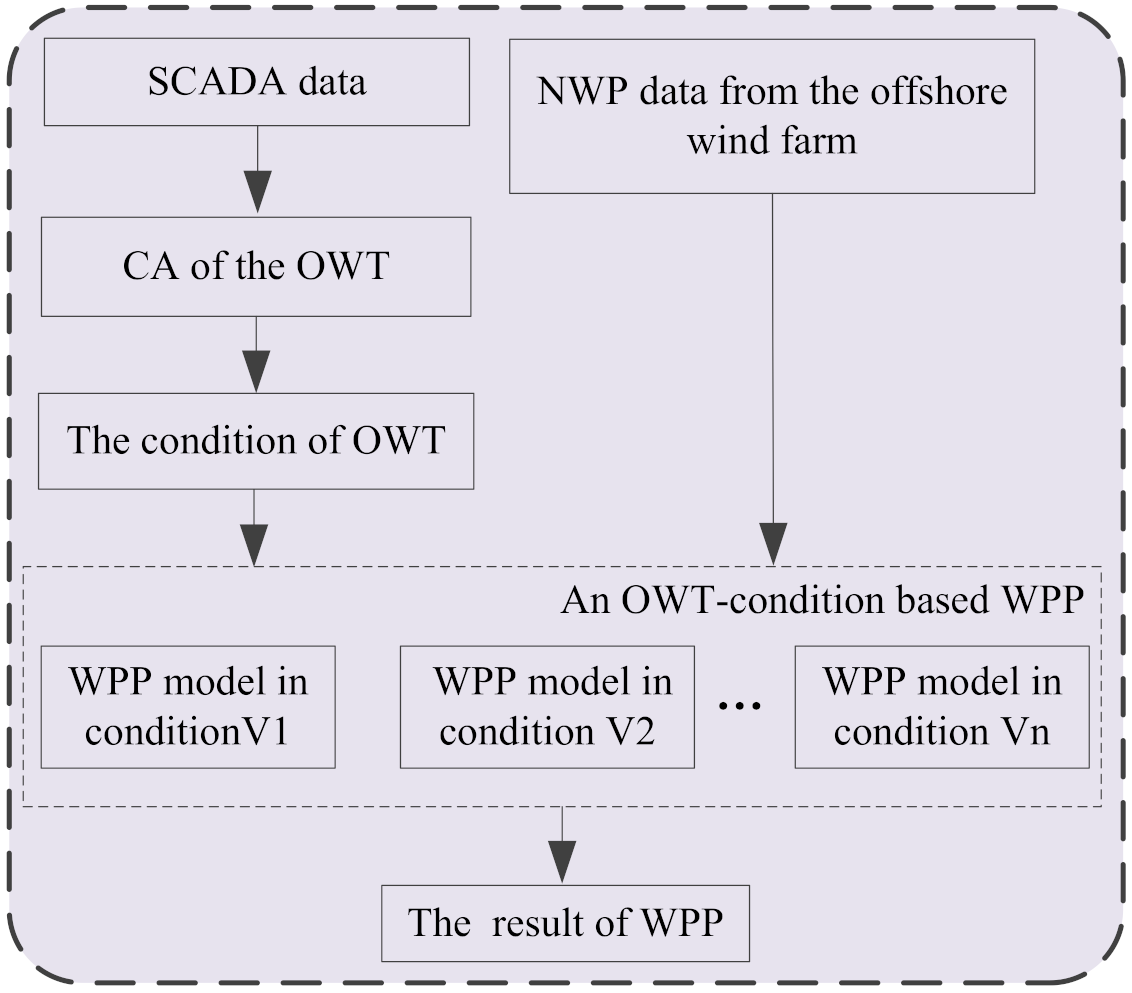
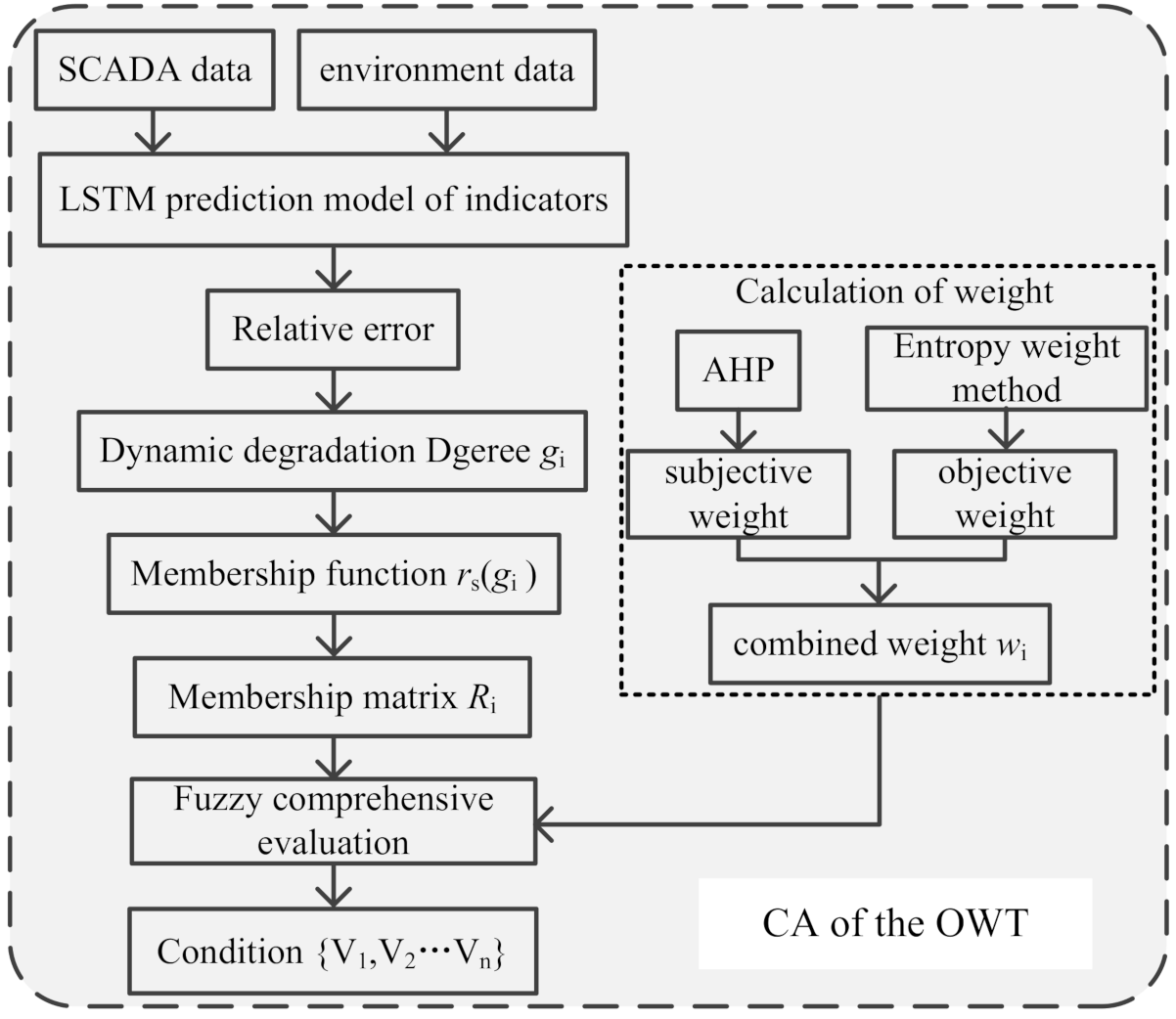




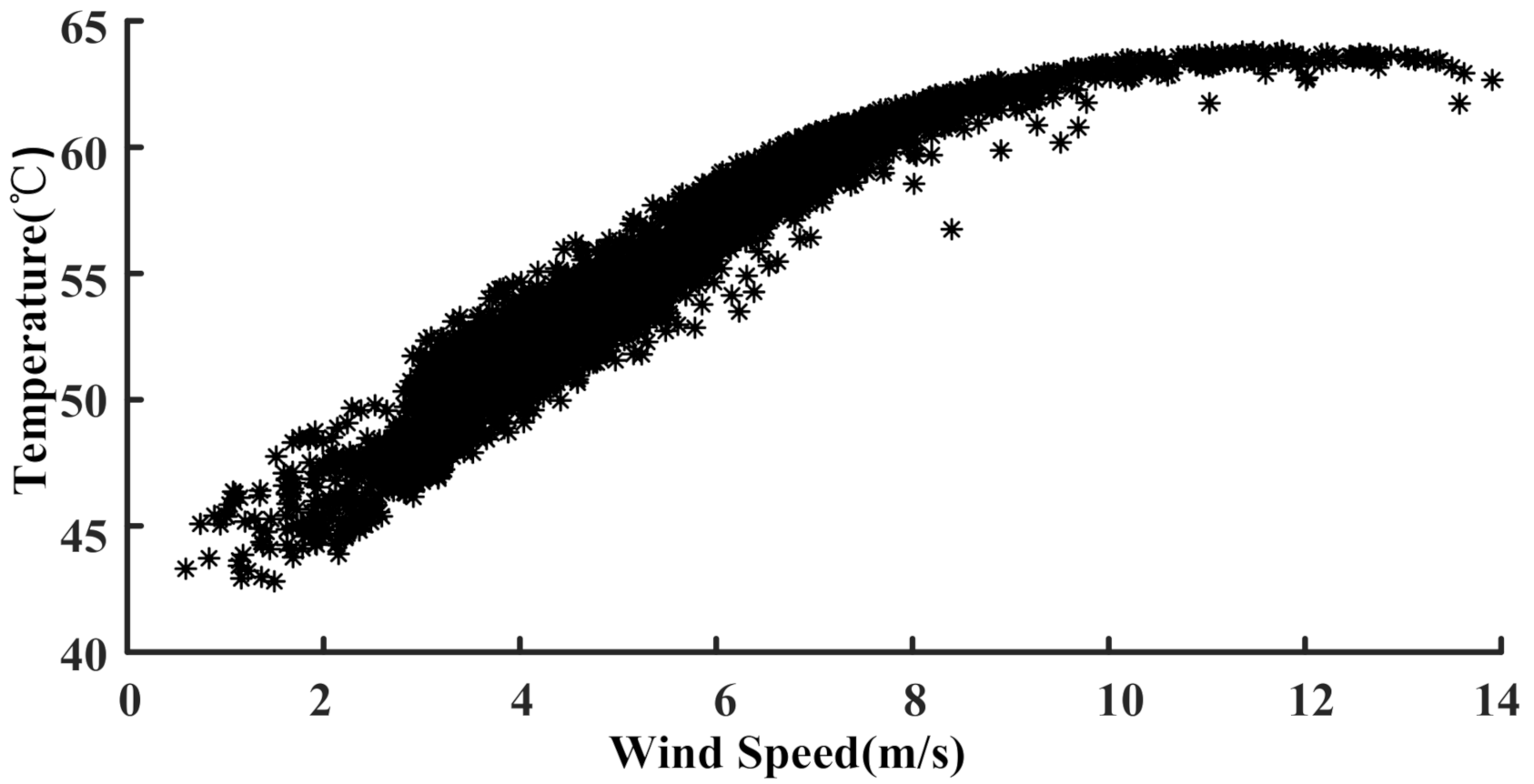

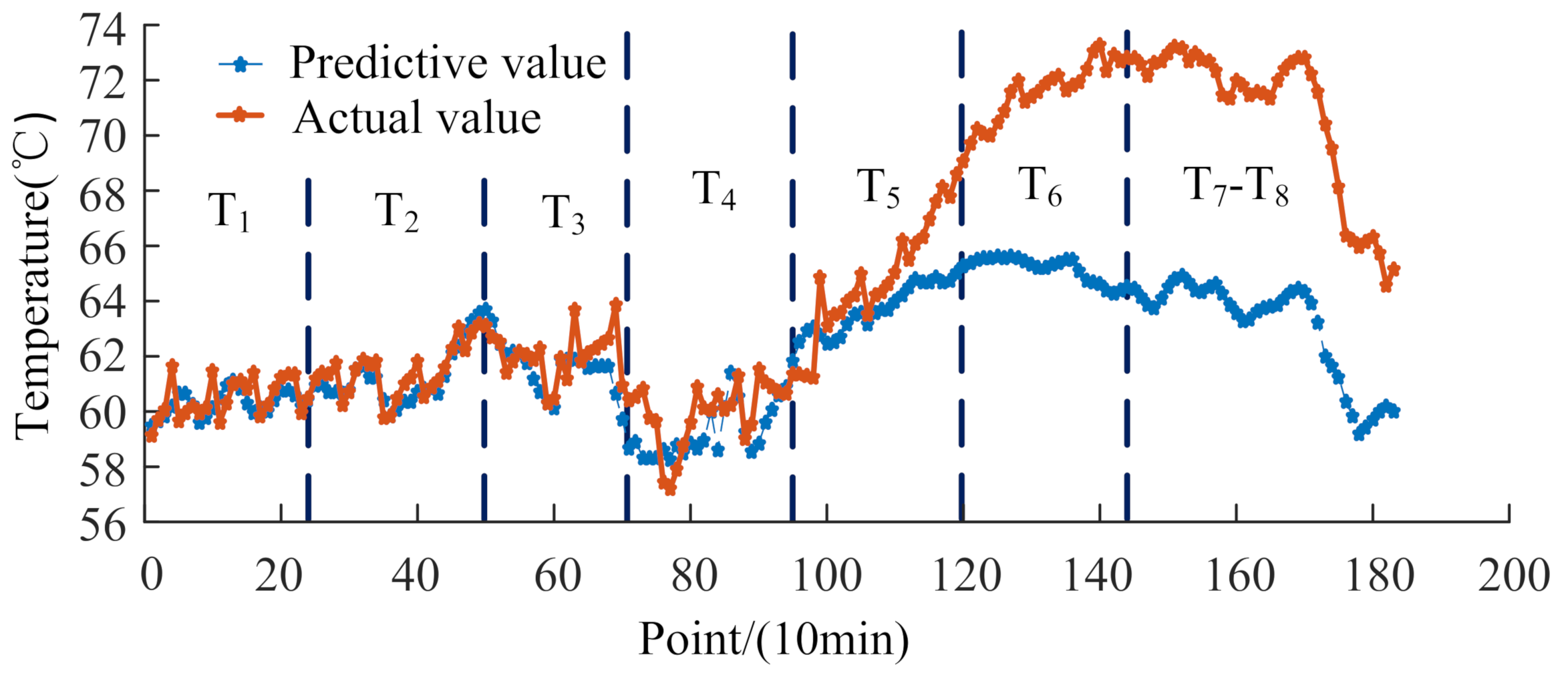

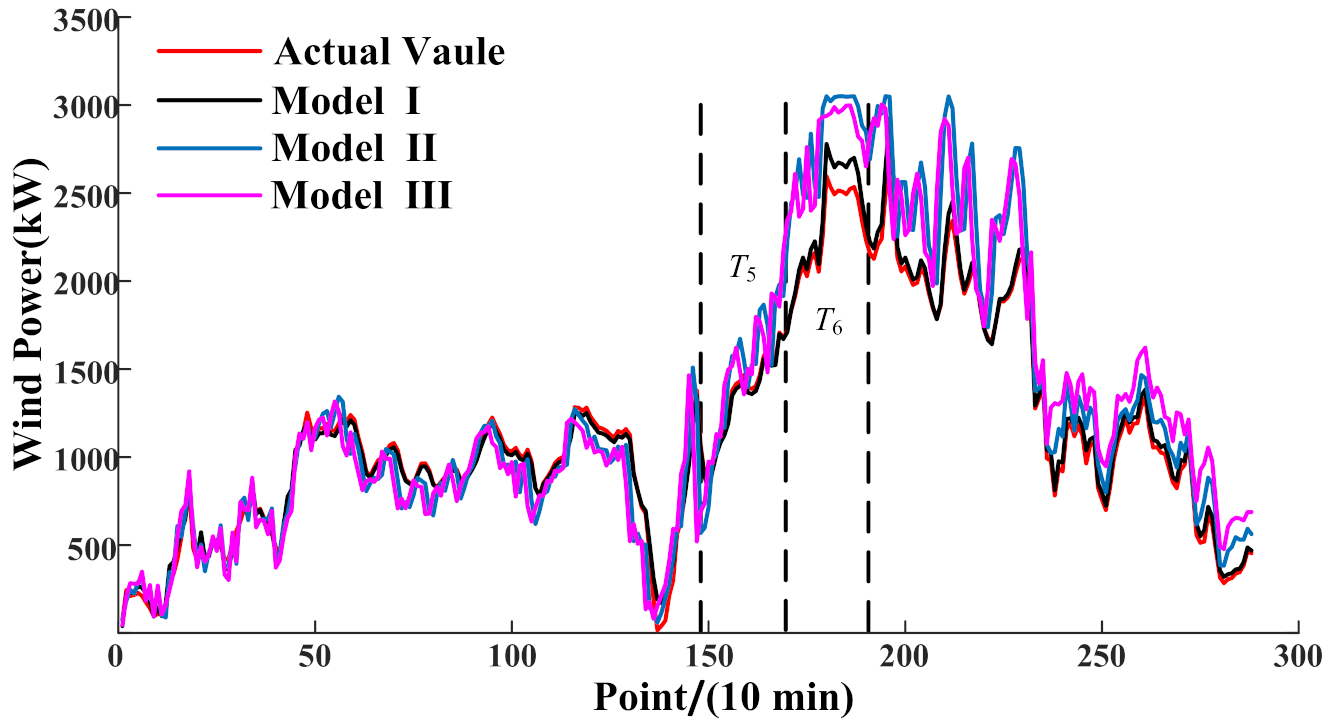
| Health Condition | Description |
|---|---|
| V1 | Excellent operating condition, the equipment is very safe |
| V2 | Good operating condition, relatively safe equipment |
| V3 | The operating status is qualified, the equipment is not safe |
| V4 | Dangerous operation status, high equipment is dangerous |
| Time | Membership Matrix of OWT | Condition of OWT |
|---|---|---|
| T1 | [1, 0, 0, 0] | V1 |
| T2 | [1, 0, 0, 0] | V1 |
| T3 | [0.99, 0.01, 0, 0] | V1 |
| T4 | [0.88, 0.12, 0,0] | V1 |
| T5 | [0.47, 0.53, 0,0] | V2 |
| T6 | [0, 0.13, 0.87, 0] | V3 |
| T7 | [0, 0, 0, 1] | V4 |
| T8 | [0, 0, 0, 1] | V4 |
| Model I | Model II | Model III | |
|---|---|---|---|
| RSME (%) | 8.74 | 10.07 | 10.12 |
| MAE (%) | 5.61 | 7.04 | 7.13 |
Publisher’s Note: MDPI stays neutral with regard to jurisdictional claims in published maps and institutional affiliations. |
© 2021 by the authors. Licensee MDPI, Basel, Switzerland. This article is an open access article distributed under the terms and conditions of the Creative Commons Attribution (CC BY) license (http://creativecommons.org/licenses/by/4.0/).
Share and Cite
Li, S.; Huang, L.-l.; Liu, Y.; Zhang, M.-y. Modeling of Ultra-Short Term Offshore Wind Power Prediction Based on Condition-Assessment of Wind Turbines. Energies 2021, 14, 891. https://doi.org/10.3390/en14040891
Li S, Huang L-l, Liu Y, Zhang M-y. Modeling of Ultra-Short Term Offshore Wind Power Prediction Based on Condition-Assessment of Wind Turbines. Energies. 2021; 14(4):891. https://doi.org/10.3390/en14040891
Chicago/Turabian StyleLi, Suo, Ling-ling Huang, Yang Liu, and Meng-yao Zhang. 2021. "Modeling of Ultra-Short Term Offshore Wind Power Prediction Based on Condition-Assessment of Wind Turbines" Energies 14, no. 4: 891. https://doi.org/10.3390/en14040891
APA StyleLi, S., Huang, L.-l., Liu, Y., & Zhang, M.-y. (2021). Modeling of Ultra-Short Term Offshore Wind Power Prediction Based on Condition-Assessment of Wind Turbines. Energies, 14(4), 891. https://doi.org/10.3390/en14040891





